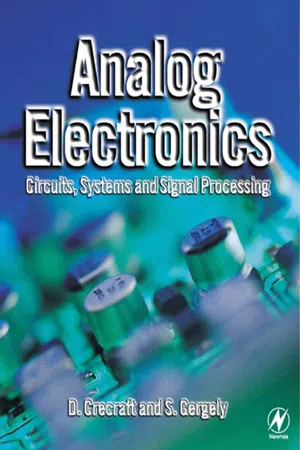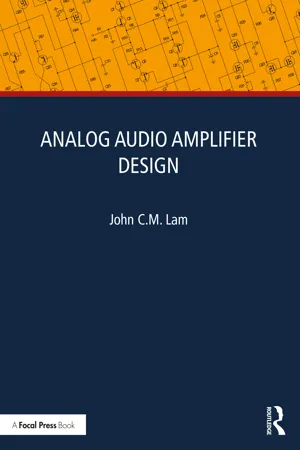Physics
Op Amp Gain
Op Amp Gain refers to the amplification factor of an operational amplifier (op amp). It represents the ratio of the output voltage to the input voltage. The gain of an op amp is a crucial parameter in determining the amplification capability and performance of the circuit in which it is used.
Written by Perlego with AI-assistance
Related key terms
Related key terms
1 of 4
Related key terms
1 of 3
11 Key excerpts on "Op Amp Gain"
- eBook - ePub
Electronics
from Classical to Quantum
- Michael Olorunfunmi Kolawole(Author)
- 2020(Publication Date)
- CRC Press(Publisher)
Section 4.2.6 .)Generally speaking, the gain of an amplifier may be specified as “output voltage/input voltage,” “output power/input power” or any other combination of current, voltage, and power. Depending on the nature of the input and output signals, we can have four types of gain :- Voltage gain (output voltage/input voltage), i.e.
(4.1)A v=V oV in
- Current gain (output current out/input current), i.e.
(4.2)A I=I oI in
- Transresistance (output voltage/input current), i.e.
(4.3)A=t rV oI in
- Transconductance (output current/input voltage).
(4.4)A=t cI oV in
How these gains are obtained would be demonstrated with examples later in the text under appropriate subheadings. In electronics, signals, and communication engineering, the gains are expressed in decibel , dB: a logarithmic unit is used to describe a ratio. As an example, the current gain (Equation (4.2)) in dB is {AI= 10log10 (Io/I in )}.Amplifier gain, in most cases, is a constant for any combination of input and output signals. When this occurs, the amplifier is considered linear . If the gain were not linear, the output signal would be distorted, e.g. by clipping the output signal at the limits of its capabilities.Amplifiers are represented by three standard symbols:- Buffer op-amp; as shown in Figure 4.2a .FIGURE 4.2 Standard symbols of op-amps: (a) buffer op-amp and (b) differential input, differential output op-amp.
- Differential input, single-ended output op-amp; the same as shown in Figure 4.1a . This type represents the most common types of op-amps, including voltage and current feedback. This differential-to-single-ended amplifier amplifies the voltage difference (V in = V + − V − ) at the input port and produces a voltageVo
- eBook - ePub
- Clive Maxfield, John Bird, Tim Williams, Walt Kester, Dan Bensky(Authors)
- 2011(Publication Date)
- Newnes(Publisher)
The open-loop voltage gain of an operational amplifier is defined as the ratio of output voltage to input voltage measured with no feedback applied. In practice, this value is exceptionally high (typically greater than 100,000) but is liable to considerable variation from one device to another.Open-loop voltage gain may thus be thought of as the “internal” voltage gain of the device, thus:where A V(OL) is the open-loop voltage gain, V OUT and V IN are the output and input voltages respectively under open-loop conditions.In linear voltage amplifying applications, a large amount of negative feedback will normally be applied and the open-loop voltage gain can be thought of as the internal voltage gain provided by the device.The open-loop voltage gain is often expressed in decibels (dB) rather than as a ratio. In this case:Most operational amplifiers have open-loop voltage gains of 90 dB, or more.11.3.2 Closed-Loop Voltage Gain
The closed-loop voltage gain of an operational amplifier is defined as the ratio of output voltage to input voltage measured with a small proportion of the output fed back to the input (i.e., with feedback applied). The effect of providing negative feedback is to reduce the loop voltage gain to a value that is both predictable and manageable. Practical closed-loop voltage gains range from one to several thousand but note that high values of voltage gain may make unacceptable restrictions on bandwidth.Closed-loop voltage gain is once again the ratio of output voltage to input voltage but with negative feedback is applied, hence:where A V(CL) is the open-loop voltage gain, V OUT and V IN are the output and input voltages respectively under closed-loop conditions. The closed-loop voltage gain is normally very much less than the open-loop voltage gain.Example 11.1
An operational amplifier operating with negative feedback produces an output voltage of 2 V when supplied with an input of 400 μV. Determine the value of closed-loop voltage gain. - eBook - ePub
- Analog Devices Inc. Analog Devices Inc. Engineeri, Hank Zumbahlen(Authors)
- 2011(Publication Date)
- Newnes(Publisher)
In all of the discussions above, we referred to the gain setting components as resistors. In fact, they are impedances, not just resistances. This allows us to build frequency dependent amplifiers. This will be covered in more detail in a later section.Open-Loop Gain
The open-loop gain (usually referred to as AVOL ) is the gain of the amplifier without the feedback loop being closed, hence the name “open loop.” For a precision op amp this gain can be vary high, on the order of 160 dB or more. This is a gain of 100 million. This gain is flat from DC to what is referred to as the dominant pole. From there it falls off at 6 dB/octave or 20 dB/decade. (An octave is a doubling in frequency and a decade is × 10 in frequency.) This is referred to as a single pole response. It will continue to fall at this rate until it hits another pole in the response. This second pole will double the rate at which the open-loop gain falls, i.e., to 12 dB/octave or 40 dB/decade. If the open-loop gain has dropped below 0 dB (unity gain) before it hits the second pole, the op amp will be unconditionally stable at any gain. This will be typically referred to as unity gain stable on the data sheet. If the second pole is reached while the loop gain is greater than 1 (0 dB), then the amplifier may not be stable under some conditions (Figure 1-7 ).Figure 1-7: Open-loop gain (Bode plot)It is important to understand the differences between open-loop gain, closed-loop gain, loop gain, signal gain, and noise gain (Figures 1-8 and 1-9 ). They are similar in nature, interrelated, but different. We will discuss them all in detail.Figure 1-8: Gain definitionFigure 1-9: Noise gainThe open-loop gain is not a precisely controlled specification. It can, and does, have a relatively large range and will be given in the specifications as a typical number rather than a min/max number, in most cases. In some cases, typically high precision op amps, the specification will be a minimum.In addition, the open-loop gain can change due to output voltage levels and loading. There is also some dependency on temperature. In general, these effects are of a very minor degree and can, in most cases, be ignored. In fact this nonlinearity is not always included in the data sheet for the part. - eBook - ePub
Analog Electronics
Circuits, Systems and Signal Processing
- David Crecraft, Stephen Gergely(Authors)
- 2002(Publication Date)
- Butterworth-Heinemann(Publisher)
3Amplifiers and feedback
3.1 Gain and decibels
As explained in Chapter 1 , the purpose of an amplifier is to increase the power of a signal. In many cases, but not all, the voltage is increased too. The voltage gain is defined as the ratio of the output signal voltage amplitude to the input sinusoidal signal voltage amplitude, at a given frequency, or over a specified range of frequencies:It must be stressed that this assumes that both input and output signals are ‘small signals’ in the sense that they are not large enough to cause the amplifier to act non-linearly (see Section 2.2.6 ). The output signal may be of many volts amplitude but, providing its waveform is still essentially sinusoidal, the amplifier can be considered linear and the expression for the gain still applies. To measure the voltage gain, a test signal is applied to the input of the amplifier. This test signal is a sine wave, as shown in Figure 3.1(a) . Recall, from Chapter 2 , that its frequency is the reciprocal of its period. Note that the amplitude is defined as the ‘peak’ value of the sine wave. A complete description of gain includes a measurement of the phase shift between output and input sine waves, but this is not always done; in many cases it is not important.Fig. 3.1 Input and output waveforms of amplifiers: (a) input waveform; (b) non-inverted output waveform; (c) inverted output waveform.The output voltage of Figure 3.1(b) is that of an amplifier with little phase shift over most of its operating frequency range. That of Figure 3.1(c) is an upside-down version of the input waveform, commonly called an inverted output. Another way of interpreting this is as a phase shift of 180°. In contrast, the waveform of Figure 3.1(b) is said to be non-inverted. - David Terrell(Author)
- 1996(Publication Date)
- Newnes(Publisher)
o ) of an amplifier can be determined by multiplying its input voltage times the voltage gain.(1.8)Let us compute the output for each of the following input voltages: −4.0, −2.0, −1.0, −0.5, −0.1, 0.0, 0.1, 0.5, 1.0, 2.0, 4.0.Now let us do similar calculations with the same input voltages applied to an ideal op amp. You can quickly realize that in all cases except 0.0 volts input, the output will try to go beyond the output limit and will be restricted to ±15 volts. For example, if 0.1 volts is appliedIn the case of 0.0 volts at the input, we will have 0.0 volts in the output since 0.0 times anything will be zero. At this point you might well be asking, “So what good is it if every voltage we apply causes the output to be driven to its limit?” Well, review Section 1.1.4 of this text, which indicates the usefulness of the op amp in general. In Chapter 2 you will become keenly aware of how the infinite gain can be harnessed into a more usable value. For now, however, it is important for you to remember that an ideal op amp has an infinite differential voltage gain.1.3.2 Common-mode Voltage Gain
Common-mode voltage gain refers to the amplification given to signals that appear on both inputs relative to the common (typically ground). You will recall from a previous discussion that a differential amplifier is designed to amplify the difference between the two voltages applied to its inputs. Thus, if both inputs had +5 volts, for instance, with respect to ground, then the difference would be zero. Similarly, the output would be zero. This defines ideal behavior and is a characteristic of an ideal op amp. In a real op amp, common-mode voltages can receive some amplification and thus depart from the desired behavior. Since we are currently defining ideal characteristics you should remember that an ideal op amp has a common-mode voltage gain of zero. This means the output is unaffected by voltages that are common to both inputs (i.e., no difference). Figure 1.13- eBook - ePub
- Beijia Ning, Beijia Ning(Authors)
- 2018(Publication Date)
- De Gruyter(Publisher)
Nowadays, manufacturers produce a large number, several hundred most probably, of various op-amps; therefore, even simple enumeration of their parameters and characteristics, such as input or output resistance, is a certain problem. It is difficult to orient designers in this abundance of types and parameters without the necessary structured knowledge about them. Therefore, the correct and reasonable choice of an op-amp for some device should include the cost, reliability and quality of the device under development.5.2Fundamentals of op-amp
An operational amplifier is a differential amplifier with a very high gain, featuring in high input impedance and low output impedance. There are many functional circuits built by op-amps, which are widely used to deal with analog signals. Moreover, an opamp may contain multiple differential amplifier stages to achieve very high voltage gain [1 , 9 ].For applications of op-amps, the common opinion is that it is not necessary to know their internal circuits; on the contrary, it is sufficient to be aware of the input and output characteristics. This way of thinking is not rare. For example, computer manufacturers scarcely know the internal structure of the Pentium microprocessor, but this does not prevent them from designing satisfactory computers. Op-amps can be considered as circuit elements like resistors or capacitors, with only a somewhat more complex internal structure.Nevertheless, the system modeling, involving the knowledge of the structure, structural relations and the principles of construction of various op-amps, allows engineers to design more competently. However, this is beyond the coverage of the textbook.So, in the following sections, the basic knowledge of op-amps will be examined as a black box and the focus will be on the set up of the network to meet design requirements.A basic op-amp is shown in Fig. 5.1 with two input terminals and one output terminal. The input terminal indicated by a plus (+) sign results in an output with the same polarity as that of input, while the one with minus (−) opposite polarity of input signal [1 , 9 , 11 , 16 ].Note that in Fig. 5.1 , the terminals of power supply and other auxiliary pins are omitted for simplicity.Fig. 5.1: Basic op-amp.1. Single-ended input mode
- eBook - ePub
- Karl Stephan(Author)
- 2015(Publication Date)
- Wiley(Publisher)
Garden-variety BJT op amps such as the 741 series have lower input resistances (~1 MΩ) and higher bias currents (10–100 nA) than FET-input devices. These values are still high enough for many purposes, but should be taken into account when using these types of op amps with high-impedance sources. Certain types of feedback circuits can increase the effective input impedance of an amplifier circuit to levels far above the op amp’s own input impedance level.The output resistance of most op amps is typically below 100 Ω and can be made artificially lower (within limits) by the proper application of feedback as well. This low output impedance is available only if the output current is limited to less than the maximum value established by the output-protection circuit, if any.5.2.3.3 Gain and Bandwidth
We will discuss these specifications together because they are best considered as two parts of the most fundamental specification, the gain–bandwidth product (GBP). As we will see when we begin discussing circuits that use op amps, there are ways of trading gain for bandwidth. But for a given op amp, the product of gain (the numeric ratio, not in dB) and the bandwidth (meaning the frequency at which the gain is 3 dB down from its DC value) is a constant, which we denote as the GBP.Because most commonly used op amps are unity-gain compensated, their open-loop gain (the gain from one input to the output with no feedback of any kind) is accompanied by a very low open-loop bandwidth, typically 1–3 Hz. (Unity-gain compensation enables the designer to use any amount of feedback up to unity (1).) This frequency, which we will call f0 , is termed the 3-dB-down frequency, which is also sometimes referred to as the cutoff frequency or the corner frequency. Because the standard definition of bandwidth is that range of frequencies over which the gain decreases from maximum by no more than 3 dB, f0 - eBook - ePub
- John C.M. Lam(Author)
- 2024(Publication Date)
- Focal Press(Publisher)
4 ]. It comprises three opamps (U1, U2 and U3). The first op-amp (U1) works as a buffer amplifier. Op-amps U2 and U3 are cross-coupled to generate the balanced output. It is demonstrated in the following that the voltage gain is determined by R2/R1. This amplifier is often used as a line driver when the amplifier is set to unity gain by choosing R1 = R2. To determine the voltage gain, let us first examine the inverted and non-inverted inputs of op-amp U2:V=− 2Vin +R 2R 1 + R 2Vol (the small 50 Ω resistor is ignored)R 1R 1 + R 2V=+ 2R 1R 1 + R 2V 02An unbalanced input–balanced output amplifierFigure4.11Since we must have V+2 = V-2 , equating the above two expressions yieldsRearranging the above expression, the voltage gain becomesR 1R 1 + R 2V 02 =Vin +R 2R 1 + R 2VolR 1R 1 + R 2(4.22)A v≡=V 02 −V01VinR 2R 1Alternatively, voltage gain can be determined by looking at the inverted and non-inverted inputs of op-amp U3. It leads to the same voltage gain as stated in Eq. (4.22). From the given values for R1 and R2 in Figure 4.11 , the voltage gain is 10. Note that there is a 50Ω resistor added to the output of the op-amp that improves the stability of the amplifier when driving capacitive load. In addition, there is a 10kΩ variable resistor connected between the two outputs. It helps to produce a symmetrical output swing between Vo1 and Vo2.Current-to-voltage amplifier
Figure 4.12(a) shows a current-to-voltage (I-to-V) amplifier. The input is now in the form of current while the output is in voltage. It is obvious that the output is given as(4.23)Vout = ( − R )Iin(a) A current-to-voltage (I-to-V) amplifier, (b) amplifying the output from a digital-to-analog converterFigure4.12The gain, –R, is negative because of the way the current direction is specified in the circuit. The most popular audio application for an I-to-V amplifier is to amplify the current signal from a DAC, as shown in Figure 4.12(b) . The purpose of the op-amp is to amplify the signal while buffering the source, DAC, with the op-amp’s high input impedance.Voltage-to-current amplifier
A voltage-to-current (V-to-I) amplifier is shown in Figure 4.13 . It is also called a Howard current generator - eBook - ePub
Introduction to Energy, Renewable Energy and Electrical Engineering
Essentials for Engineering Science (STEM) Professionals and Students
- Ewald F. Fuchs, Heidi A. Fuchs(Authors)
- 2020(Publication Date)
- Wiley(Publisher)
8 Operational Amplifiers8.1 Introduction
The operational (OP) amplifier is a basic building block for the design of analog electronic systems such as feedback control circuits [1 ], where the angular velocity ω m (t), angular position θ m (t) = ∫ω m (t)dt, current i(t), and torque T(t) must be controlled. An OP amplifier with no external circuitry is a voltage amplifier with a very high open‐loop voltage gain that ideally approaches infinity A v → ∞, as shown in a symbolic manner in Figure 8.1 . Note that input/output voltages can be either time varying or time independent, and they can be either periodic or nonperiodic.OP amplifiers are integrated circuits (IC), which can be purchased off the shelf, and they contain transistors, diodes, resistors, and capacitors all fabricated on a single silicon chip. Inductors are bulky and are mostly avoided in OP amplifier designs. The analog electronic circuit of Figure 8.1 has two inputs: a negative (v − ) and a positive (v + ) input supplied by the voltages v in1 and v in2 , respectively, whose difference in voltage (v in2 − v in1 ) produces an output signal voltage v out that is a replica of the input voltage difference. The two‐input voltage approach is useful because stray signals/electric noise that appear on both inputs are cancelled, and only the voltage difference is amplified. An OP amplifier is also called a differential amplifier because the output voltage is a voltage that is A v times the voltage difference between the two inputs. During the past half century, OP amplifiers have been refined and improved to the extent that they have nearly ideal properties, and therefore we discuss in this textbook the performance of ideal OP amplifiers only. The understanding of nonideal properties of OP amplifiers requires detailed electronic knowledge [2 - eBook - ePub
- Peter Wilson(Author)
- 2011(Publication Date)
- Newnes(Publisher)
5 (100 dB) at DC. The actual gain, from the feedback equation, isNow raise the frequency to the point at which it is a decade below the maximum expected bandwidth at this gain. This will have reduced AOL to ten times the closed-loop gain or 1000. The actual gain is nowwhich shows a ten per cent gain reduction at one-tenth the desired bandwidth!AOL also changes with temperature. The data sheet will not always tell you how much, but it is common for it to halve when going from the low-temperature extreme to the high extreme. If your circuit is sensitive to changes in closed-loop gain, it would be wise to check whether the likely changes it will experience in AOL are acceptable and if not, either reduce the closed-loop gain to give more gain margin, or find an op-amp with a higher value for AOL .5.2.12 Noise
A perfect amplifier with perfect components would be capable of amplifying an infinitely small signal to, say, 10 V p–p with perfect resolution. The imperfection which prevents it from doing so is called noise. The noise contribution of the amplifier circuit places a lower limit on the resolution of the desired signal, and you will need to account for it when working with low-level (sub-millivolt) signals or when the signal-to-noise ratio needs to be high, as in precision amplifiers and audio or video circuits.There are three noise sources which you need to consider:• amplifier-generated noise; • thermal noise; • electromagnetic interference.The third of these is either electromagnetically coupled into the circuit conductors at RF, or by common mode mechanisms at lower frequencies. It can be minimized by good layout and shielding and by keeping the operating bandwidth low, and is mentioned here only to warn you to keep it in mind when thinking about noise. Chapter 8 discusses EMC in more depth.Definitions
Two important definitions for noise calculations are the mean value and the root mean square (RMS) value. For any signal we can calculate the mean value using the integration over a time period as shown by: - eBook - ePub
Understanding Microelectronics
A Top-Down Approach
- Franco Maloberti(Author)
- 2011(Publication Date)
- Wiley(Publisher)
stabilized chopper . With these methods it is possible to obtain offsets of a few μV.6.6.2 Finite GainIf the output voltage of an op-amp with finite gain A 0 is V out , its differential input is not zero but −V out /A 0 . For normal cases the error is small but is output dependent. It influences the behavior of the scheme by an extent that depends on the scheme itself and the vales of passive components. For example, the finite gain in the inverting amplifier of Figure 6.26 determines the conditionFigure 6.26 Inverting amplifier that uses an op-amp with finite gain A 0 .(6.49)That condition also implies I 1 = I 2 . The solution of equation (6.49) is(6.50)which, obviously, becomes the ideal result when A 0 → ∞.Equation (6.50) includes the inverting gain −G = −R 2 /R 1 with ideal op-amp. More markedly(6.51)which defines a relative gain error, εG = (G +1)/A 0 .If, for example, an inverting amplifier with gain − 20 needs an error εG lower than 0.1%, the finite gain A 0 should verify the condition ((G +1)/A 0 ) < 0.001. Therefore, the required minimum gain is A 0 > 21 000 ( ~ 86 dB), a value that is achievable but not easy to sustain for a large interval of the output voltage.The above result shows that A 0 must be high when the expected signal amplification is high. However, since the signal gain is the ratio between resistors, the accuracy of that ratio depends on the matching accuracy. The errors caused by finite gain and matching are summed, and it may be that the second one is dominant. However, the mismatch error is static while the finite gain error, which depends on A 0
Index pages curate the most relevant extracts from our library of academic textbooks. They’ve been created using an in-house natural language model (NLM), each adding context and meaning to key research topics.
Explore more topic indexes
Explore more topic indexes
1 of 6
Explore more topic indexes
1 of 4










